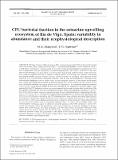Por favor, use este identificador para citar o enlazar a este item:
http://hdl.handle.net/10261/25329COMPARTIR / EXPORTAR:
 SHARE SHARE
 CORE
BASE CORE
BASE
|
|
| Visualizar otros formatos: MARC | Dublin Core | RDF | ORE | MODS | METS | DIDL | DATACITE | |

| Campo DC | Valor | Lengua/Idioma |
|---|---|---|
| dc.contributor.author | Zdanowski, M. K. | - |
| dc.contributor.author | Figueiras, F. G. | - |
| dc.date.accessioned | 2010-06-16T11:03:55Z | - |
| dc.date.available | 2010-06-16T11:03:55Z | - |
| dc.date.issued | 1999-06-11 | - |
| dc.identifier.citation | Marine Ecology Progress Series 182: 1-15 (1999) | en_US |
| dc.identifier.issn | 0171-8630 | - |
| dc.identifier.uri | http://hdl.handle.net/10261/25329 | - |
| dc.description | 15 pages, 8 figures, 4 tables. | en_US |
| dc.description.abstract | Between October 1990 and August 1991 colony-forming unit (CFU) bacteria at the centre of the Ría de Vigo, Spain, comprised on average 1% of total bacterioplankton, with a maximum of 6.8% in mid-April. In contrast to relatively small fluctuations in total bacterioplankton, fluctuations in CFUs were considerable, with the coefficient of variation ranging from 112 to 233%. Over 40% of the variance in CFU abundance in the surface layer during the whole period of observations (winter and summer) could be explained through an equation relating logCFU to incoming solar radiation, and during the summer months through another equation relating logCFU to upwelling. Both physical factors enhanced CFU concentrations. Biological variables, such as total bacterioplankton, chlorophyll and heterotrophic flagellates, had no further effect on the explained variance. At the bottom of the photic zone, runoff and upwelling accounted for between 29 and 50% of the variance in CFU counts. In this layer, biological variables had a great influence on CFU abundance, increasing the explained variance to 61% for the whole period studied. In this case, chlorophyll was negatively related to logCFU suggesting that the CFU bacterial fraction was more abundant in the water column after the decline of the phytoplankton blooms and after the corresponding release of bacteria attached to particles. At the bottom of the water column, seawater temperature was the only important factor in explaining the variance in CFU counts (36%), with logCFU and temperature being positively related. We hypothesise that 3 factors are prominent in controlling the CFU standing stock: solar radiation and upwelling stimulate the synthesis of particulate organic matter in surface waters, providing a food source for CFU bacteria, and terrestrial runoff which dilutes bacterial numbers. Based on cluster analyses of physiological tests, on pure bacterial isolates from 2 contrasting sampling dates, we show that prevailing hydro- and meteorological conditions select for different bacterial species in the CFU community. Lower CFU counts and diversity within the population, plus lower frequencies of positive responses in physiological tests arose through very high upwelling and NW winds which introduced CFU-poor water masses from the Atlantic Ocean into the Ría de Vigo. Conversely, terrestrial runoff and NE winds enhanced diversity within this population at the centre of the estuary, through the introduction of terrestrial bacteria or those from shallow waters; these were characterised by higher numbers of positive responses in physiological tests. | en_US |
| dc.description.sponsorship | This study was supported by the European Union's MAST project, contract MAST-CT90-0017 M.K.Z. thanks the 'Ministerio de Educación y Ciencia and Ministerio de Asuntos Exteriores' in Spain for the financia1 support that enabled him to conduct this research in Vigo during 1990-1991. | en_US |
| dc.format.extent | 1465055 bytes | - |
| dc.format.mimetype | application/pdf | - |
| dc.language.iso | eng | en_US |
| dc.publisher | Inter Research | en_US |
| dc.rights | openAccess | en_US |
| dc.subject | CFU bacterial fraction | en_US |
| dc.subject | Hydrographic variability | en_US |
| dc.subject | Upwelling | en_US |
| dc.subject | Runoff | en_US |
| dc.subject | Ecophysiology | en_US |
| dc.subject | Estuarine ecosystems | en_US |
| dc.subject | Ría de Vigo | en_US |
| dc.title | CFU bacterial fraction in the estuarine upwelling ecosystem of Ría de Vigo, Spain: variability in abundance and their ecophysiological description | en_US |
| dc.type | artículo | en_US |
| dc.identifier.doi | 10.3354/meps182001 | - |
| dc.description.peerreviewed | Peer reviewed | en_US |
| dc.relation.publisherversion | http://dx.doi.org/10.3354/meps182001 | en_US |
| dc.type.coar | http://purl.org/coar/resource_type/c_6501 | es_ES |
| item.openairetype | artículo | - |
| item.grantfulltext | open | - |
| item.cerifentitytype | Publications | - |
| item.openairecristype | http://purl.org/coar/resource_type/c_18cf | - |
| item.fulltext | With Fulltext | - |
| item.languageiso639-1 | en | - |
| Aparece en las colecciones: | (IIM) Artículos | |
Ficheros en este ítem:
| Fichero | Descripción | Tamaño | Formato | |
|---|---|---|---|---|
| m182p001.pdf | 1,43 MB | Adobe PDF |  Visualizar/Abrir |
CORE Recommender
SCOPUSTM
Citations
16
checked on 03-abr-2024
WEB OF SCIENCETM
Citations
16
checked on 29-feb-2024
Page view(s)
473
checked on 22-abr-2024
Download(s)
658
checked on 22-abr-2024
Google ScholarTM
Check
Altmetric
Altmetric
NOTA: Los ítems de Digital.CSIC están protegidos por copyright, con todos los derechos reservados, a menos que se indique lo contrario.
